Apps for Apes - RZSS
- Bailey Tuddenham

- Apr 8, 2023
- 3 min read
Updated: Apr 24, 2023

One of the most interesting takeaways from my visit to Edinburgh Zoo was hearing about and witnessing their use of technology to research their chimpanzees.
Collaborating with the University of St Andrews, RZSS have a laboratory called BRU (Budongo Research Unit). PhD students from the university visit the lab regularly to carry out a range of research experiments with the chimps, in order to, essentially, gain a better understanding of how their brains work. During these research experiments, they use a wide range of technologies, which will be mentioned throughout this post.
RZSS make it clear that all research experiments carried out by the chimps are completely voluntary, and the chimps can choose to take part and leave at any time. All research experiments are 100% non-invasive, and are designed to be enjoyable for the chimps to take part in.
In order to gain a better understanding of what is happening in the BRU lab, I reached out to Emma McEwen, a postdoctoral researcher at the University of St Andrews. Emma also carried out her PhD at St Andrews from 2018 to 2023. I asked her a series of questions, and her answers can be seen below.
Emma McEwen - Postdoctoral Researcher (St Andrews)
What degree are you studying, and what does it entail?
My research with the chimps was for a PhD in Psychology at the University of St Andrews, more specifically, the field of Comparative Psychology. This entailed designing and running a series of experiments, and writing a thesis. My topic was chimpanzee cognition in joint action and virtual environment navigation. My research involved using physical tasks, and touchscreen tasks with chimps in Edinburgh Zoo and Leipzig Zoo.
What projects have you been working on with RZSS?
At Edinburgh Zoo, I worked on training several chimps to use touchscreens. Much of this involved using virtual environments which look like cartoon video games that the chimps can move an avatar around to collect virtual food (viewed from a first-person perspective). Other projects have included cooperative tasks between a chimp and an experimenter such as passing a tool and moving food rewards through vertical maze puzzle boxes. All of the research is entirely voluntary, the chimps are free to come and go as they please and only engage with the research if they choose to, and always on their own terms! If subjects do not want to participate, they simply do not. We offer them food rewards for participating, but these are in addition to their usual diets, and they are never food or water deprived.
How has technology benefitted your research?
Touchscreen technology has several benefits in primate cognition work. Lots of our work involves lots of video coding of behaviours, but with touchscreens we can use software to record their every touch and the exact time that they touch the screen. This is useful for working out their task accuracy, and their latencies to act. Additionally, we can present subjects with novel stimuli, and study aspects of cognition that can be challenging to study in captive settings such as large-scale spatial cognition. It's also engaging and exciting for visitors to watch, and for the chimps to play with.
Do you think any of the technology that you’re using with the chimps could be transferable to research projects with other animals?
Yes, touchscreen research is already used across animal species, and I think the number of species it is used with will continue to increase.
My thoughts
The information that Emma provided me with was extremely useful, and I want to take this opportunity to thank her for her time and support! The use of technology within the research being carried out at BRU is incredible. These are, definitely, the most technology-based research methods that I have discovered during this project, and are a clear example of how technology could benefit conservation efforts.
Her response to my question about the potential to use technology with other animals is a positive one, and gives me great hope for considerations of technologies to benefit polar bears.
See More:
For an example of the virtual environment work carried out by Emma and the rest of the team, you can find their recent paper below:






